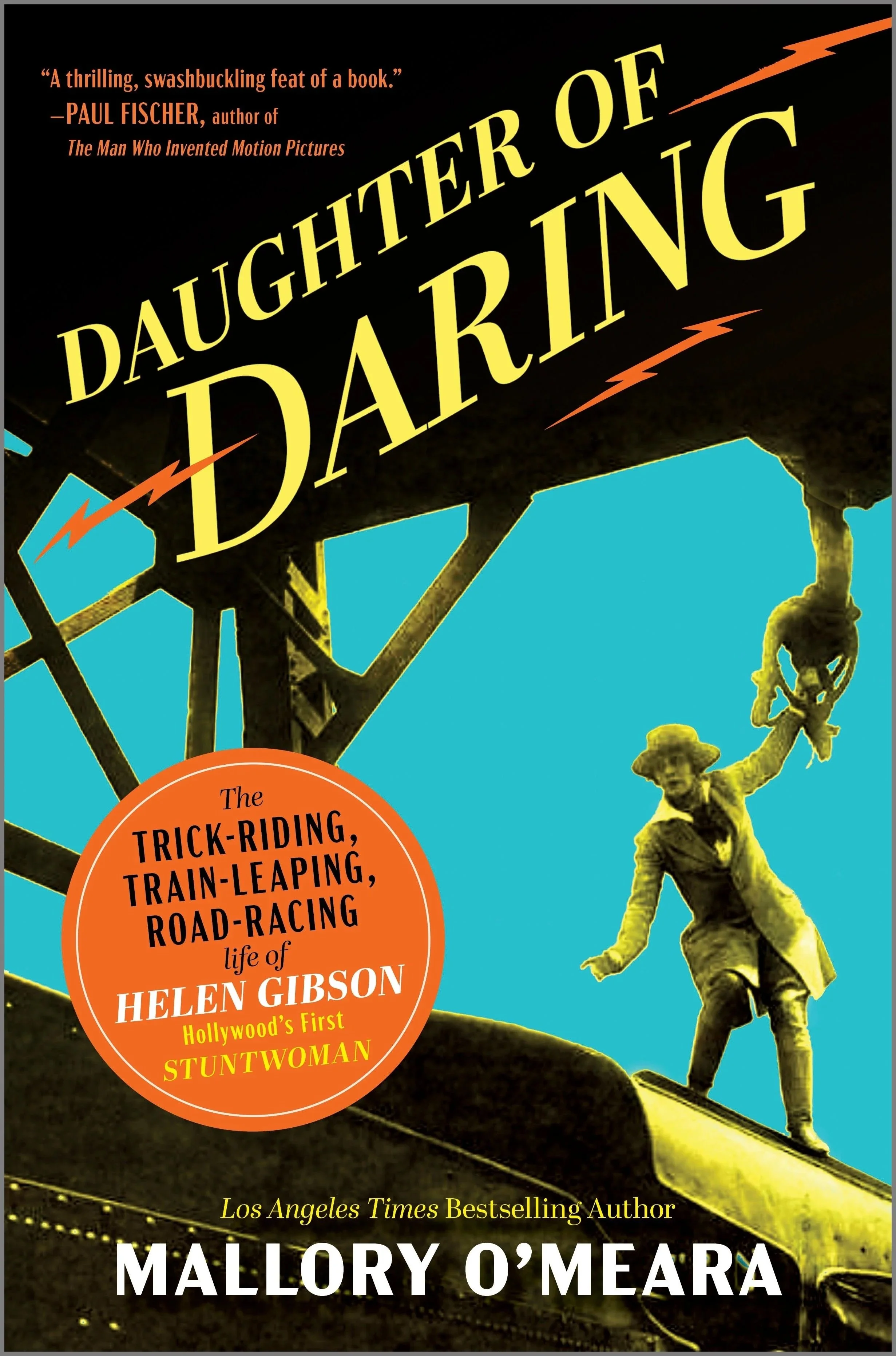Daughter of Daring: The Trick-Riding, Train-Leaping, Road-Racing Life of Helen Gibson, Hollywood’s First Stuntwoman by Mallory O’Meara
Publication Date: Feb. 18, 2025 | Hanover Square Press | 384 pages
Imagine a film industry dominated by women. Directors, producers, screenwriters, and headlining stars — all women. This wasn’t just some Hollywood Barbie-like flight of fancy, but the reality of motion picture making as it was back in the silent film era of the 1910s and ‘20s. Back them, women were not just common place, but larger than life and in charge of damn near all of it. They were the heroes of the silver screen, leaping off horses and onto hijacked trains to punch out or shoot down the dastardly men robbing people blind, or celebrating bodily autonomy in dramas about abortion, sex, and women’s rights. These women were in front of and behind the camera, crafting stories for the predominately women audiences all across America to live vicariously through, in a time when women didn’t even have the right to vote and were mostly stuck in a life of housewifery.
The biggest star of the time was Helen Gibson, a former rodeo star who worked her way up from background actor to certified star — and Hollywood’s first stuntwoman. Ginger Rogers may have had to do everything Fred Astaire did backwards and in heels in the 1930s, but before that, Gibson was on film doing everything her male counterparts were doing onscreen without padding, wires, or safety harnesses. When she leapt off the back of a car — or out of an airplane — and onto a speeding train, or did a jump trick on a motorcycle over a flatbed car, she actually one hundred percent went for it, and oftentimes in a long dress that could get snagged on something and potentially kill her. She didn’t have the luxury of green screen and CGI, or even crash landing pads. There was only one shot at a stunt, because to mistime a leap wouldn’t just mean a ruined shot, but the loss of limb or life. Gibson was a bona fide action hero, a female Tom Cruise many decades before there was a Tom Cruise, performing one hair-raising stunt after another and constantly looking to raise the stakes with each outing as cars and airplanes were introduced and made staples of American life.
Gibson, and other women like her, ruled the box office for nearly two decades, and helped build Hollywood into the titan of industry it would become in The Golden Age…which was also the period in which control over film was wrestled away from women and turned into a massive boy’s only club. Mallory O’Meara explores these decades that paint the backdrop of Gibson’s life and career throughout Daughter of Daring, a wonderfully feminist exploration of Hollywood in its infancy and development of the studio system in the years following the First World War. O’Meara delivers a thoroughly researched accounting of women’s agency and it’s “women-made women” powerhouses in front of the camera and behind the scenes, as well as a terribly sobering examination of how the legacy of women in Hollywood was stolen out from under them by various cabals of jealous men and right-wing, white, Christian censorship boards looking to profit off everything these women built and completely strip them of their power and influence until they were mostly forgotten entirely.
O’Meara’s exploration of the growth and development of Hollywood as it became what we know it today is an intriguing, not to mention sobering, look at how things used to be, how far certain groups — namely women and minorities — have fallen, and how far we as a society have yet to go (and will likely have even that much further to go after a second ruinous term of the Trump administration and whatever his plans are for his recently announced three-man band of washed-up, racist, sexist misogynistic actors cum Hollywood Ambassadors confessing to Sean Hannity their longing to be spanked by daddy). Only a few days ago, the nominees for the 97th Academy Awards were announced with plenty of fanfare around Coralie Fargeat’s Best Director nod for the 2024 horror film, The Substance. That a horror film was able to garner five nominations from the notoriously stodgy and historically horror-averse Academy was something of a feat in and of itself, let alone a horror film helmed by a woman and centered around women. Demi Moore also earned a nomination for Best Actress, hot off the heels of her recent Golden Globes win. But Fargeat’s nomination is itself a pretty big deal, making her only the tenth woman in Oscar history to be recognized. To date, only three have actually won. Ten nominations and three wins. In 97 years. Ninety-seven years. Ninety-fucking-seven years!
The typical argument is that there’s so few women directors in Hollywood, and while true now, it’s also important to recognize that it wasn’t always like that! O’Meara does a fabulous job driving this point home throughout the course of Daughter of Daring, exploring and explaining how this atrocious inequity arose and became reinforced in the years following the suffrage movement. It’s absolutely heartbreaking to have gone from hundreds of silent films crafted by women to modern-day studios committing to, maybe, maybe, one women-lensed picture a year — maybe, you know, if they’re good, as a treat; to have gone from a period of such prestigious influence for women in the 1910s and ‘20s to the era of #MeToo a century later. One can’t help but look at the work of Helen Gibson, as recounted by O’Meara, and the women that helped make her career and shape Hollywood in its opening act, and think, sadly and wistfully, they really don’t make films like that anymore.

